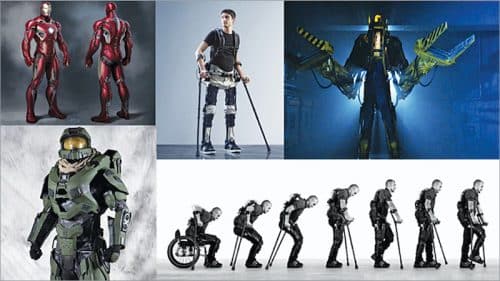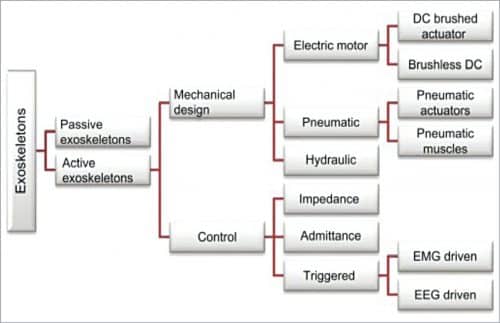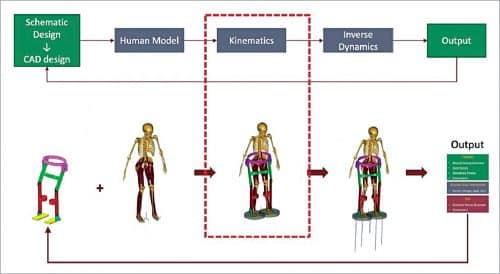Exoskeletons are ideal for use in almost every industry, including medical, agriculture, automobile, construction, manufacturing, and so on. These can help people maintain fitness and prevent health issues as well as help those who face hardships in performing daily tasks.
From old science-fiction movies like Aliens to the new ones like Avengers, it has been common in films to feature fascinating robotic exoskeletons. But their availability in real life is much more usual than one would notice.
The term exoskeleton literally means an external skeleton structure wherein the skeletal system is outside an organism’s body, as seen in arthropods like spiders, insects, and crustaceans. Borrowing and translating this idea, just like many other innovations, the military was the first to combine robotics and biomechatronics to create wearable frameworks that could be worn on a specific body part, or even on the entire body, to boost a human being’s performance.
Unlike an autonomous robot, it does not replace the worker altogether. Neither does it work like a prosthetic that replaces the original amputated body part. According to a report from MarketsandMarkets, the exoskeleton market is predicted to grow to 2,810.5 million dollars by 2023.

Types of exoskeletons
There can be many types of exoskeletons based on different classifications. Depending on the powering mechanism, there are mainly two types—passive and active. Passive systems are without actuators, sensors, motors, or batteries, are less expensive and mostly preferred by skilled workers in factories. Since these do not have any electrical power source, motion is controlled with springs and dampers. Take the example of Airframe exoskeleton from the tech company Levitate Technologies. It uses a pulley mechanism instead of electricity.
Powered or active exoskeletons use data from sensors to monitor and respond to persons’ movements. Different ways of powering the exoskeletons, including pneumatics, electrical motors, and hydraulics, can be used to improve the strength and endurance of a person’s body.
How does it work?
Interaction of exoskeleton with the user involves three main steps—sense, decision, and execution. Fitted with motorised muscles usually, the suit makes it easier to work with heavy objects as it makes them feel much lighter, and hence easier to lift and move.

Advancements in robotics are helping in the creation of intelligent solutions. Predictive algorithms and artificial intelligence allow a faster response from exoskeletons in real time.
The cognitive human-robot interaction part consists of algorithms and control strategies to deal with how the user controls the exoskeleton. Sensing and decision-making are made possible using the information from human operators as well as sensors in the wearables.
The focus is on decreasing stress and strain that is usually exerted on muscles and joints.
For physical human-robot interaction, in case of lifting, for example, the weight of arms is transferred to cores of the neck, shoulder, and back for even distribution of energy. When the body part (here, arm) comes back to its resting position, the support is slowly taken off.
These wearables can be made of either rigid materials like carbon fibre or sometimes soft materials such as special kinds of fabric, depending on the application requirements. The actuators made with soft materials are also lightweight, making them useful for such places as the ankle and hand, which require careful movements.
Testing of performance is done via measurement of the interaction forces between the device and the user’s limbs during the execution of a task.
Applications
The capabilities and benefits offered by the exoskeletons make them ideal for use in almost every industry, including medical, agriculture, automobile, construction, manufacturing, and so on. These can help people maintain fitness and prevent health issues as well as help those who face hardships in performing daily tasks.
Their use in industries helps workers avoid chronic health issues. These can also prove to be highly beneficial for first responders and firefighters in disastrous situations. For example, NASA’s X1 robotic exoskeleton would allow astronauts to improve their exercises by the addition of resistance force. The data can be recorded and sent to Earth, where doctors can provide feedback.
As per a World Health Organization report, one billion people or fifteen per cent of the total world population experiences some form of disability. These people are more vulnerable to adverse socio-economic experiences. In healthcare, the exosuits are mainly needed in rehabilitation and therapeutic applications to improve the quality of life of patients.
Exosuits are designed for multiple medical conditions, including stroke, cerebral palsy (CP), incomplete spinal cord injury, multiple sclerosis (MS), traumatic brain injury (TBI), and many more. These help patients in regaining limb strength and perform day-to-day tasks that involve walking or using their arms. Exosuits enable paraplegics to stand up and walk at a consistent pace again. These can help in dealing with obesity and balancing body parameters caused by increased sitting time and decreased level of physical activity.
On-board sensors enable accurate tracking of a patient’s progress over time; the data is valuable in ensuring a balanced approach. This reduces the work of therapists as assistance can be simply customised to the needs of individual patients.
During body movements, nerve signals are sent from the brain to muscles via motor neurons. To give it a more natural feel, bio-sensors are attached nowadays so that a wearer’s intention can be understood in advance from the bio-signals received, and response from exoskeleton can be simultaneous. Researchers are also working on electroencephalogram (EEG) bio-sensors that can measure activity across the user’s head. The suits can be mobile or fixed/suspended according to requirements.
Solutions like Lokomat from Hocoma, a producer of robotic and sensor-based devices, give ergonomic support to the suffering people and allow the doctors to observe the patient’s movements easily. Other companies making exoskeleton suits include Exo Bionics, ReWalk Robotics, Cyberdyne, Meditouch, and Bionik Laboratories.
Robotic exoskeleton from ReWalk has even received Food and Drug Administration (FDA) clearance for personal and rehabilitation use in the United States. It allows people with SCI to perform leg movements necessary for standing upright, walking, turning, and also using stairs.
Earlier, huge investment risks caused less manufacturers to tap this market. But these days, companies are offering fee-based, Robotics-as-a-Service pricing models for ensuring economic viability. Different types of exoskeletons are now available commercially. With a decrease in the cost of these wearables, hospitals can employ a wide variety of exosuits for meeting the needs of various patients.
With advancements in robotic technologies and growing demand from the healthcare sector for robotic rehabilitation, a number of companies are realising the benefits they can gain from the adoption of exoskeletons. At CES 2020 event in Las Vegas, Korean tech giant Samsung unveiled a fitness exoskeleton as well as a rolling robot that shows their interest in the healthcare field.

Leveraging the pros and dealing with the cons
There are numerous benefits of using exoskeletons in different fields. Several reports have findings that prove the safety of exoskeleton training, which indicates a likely positive growth of this field in future.
Exoskeletons make people less prone to fatigue resulting from performing repetitive tasks for long durations, musculoskeletal disorders, or long-term injuries from accidents. Complex movements become easy with them because of jointed appendages.
These also prevent physical damage on the goods/materials side. Compared to previously existing options in the market, exoskeletons offer much more flexibility in work.
But at the same time, there are numerous problems too. Their structural design needs to accommodate several parameters and is difficult to make. Another problem is that their sometimes bulky and rigid structure can make them uncomfortable as a wearable. The manufacturers also need to fulfill stringent government regulations pertaining to medical applications.
In older designs, powering the exoskeletons required workers to be tied to a power source. But now, designs can be powered by small battery units that provide sufficient charging for long durations. Since the technology is still evolving with worldwide prototype tests going on, the use of next-gen exoskeletons in critical applications still has a long way to go.
Growth in India
India has also seen an increasing number of companies and startups in this field, especially in the last five years. In 2015, ReWalk Robotics announced a partnership with Saimed Innovations, a medical technologies provider, as part of an effort to distribute their exoskeleton systems in the country.
Being manufactured with a focus on Indian customers, the exoskeletons from Indian healthcare startup GenElek can do all the necessary work and are available at a low cost. Their technology works towards strengthening limb and hand movements for the rehabilitation of patients. It aids in reducing the recovery time too.
In February 2020, at Future Decoded tech summit, Microsoft showcased Bionic Yantra as one of the innovative startups on its cloud platform. The Indian startup developed an exoskeleton for people with spinal injuries to help them move their limbs in controlled conditions. With the assistance of the Internet of Things (IoT) and machine learning (ML), the data can be used for keeping a check on progress achieved and predicting patient recovery
Research is ongoing to develop next-gen exosuits by both private and government sectors, with labs of institutions like Defence Research and Development Organisation (DRDO)’s Defence Bioengineering and Electro-medical Laboratory (DEBEL) at the forefront. This is not just essential for adopting technology as a tool to address social needs, but also for boosting the Indian economy.







